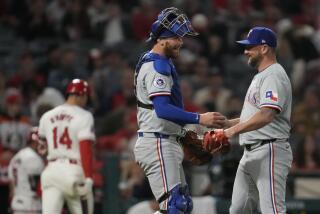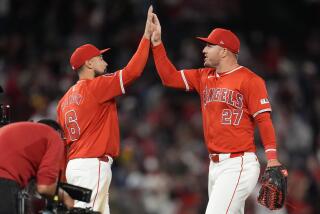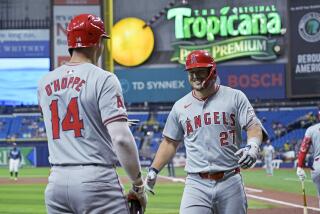Angels’ Opponents Eliminate the Middlemen
- Share via
In almost every conversation about the Angels’ deficient offense, Manager Mike Scioscia, when it comes to middle-of-the-order hitters Vladimir Guerrero and Garret Anderson, will say something like, “We can’t rely on Vlad and G.A. to carry us,” or, “It can’t all be on their shoulders; we need contributions from others to win games.”
That’s true, but the Angels need something from Guerrero and Anderson, or at least a lot more than they’ve been getting, if they’re to pull themselves out of a season-long funk and make some kind of run for their third consecutive American League West championship.
Guerrero, the 2004 AL most valuable player, and Anderson, one of baseball’s most consistent run-producers from 2000 to 2003, are supposed to be the foundation of the Angels offense, the constants, the players the team can rely on.
Though Guerrero and Anderson are capable of carrying the club for periods of time, the Angels don’t necessarily need them to hoist the team on their backs this summer. But they need the pair to start doing their share of the heavy lifting.
Guerrero was mired in an 11-for-76 slump that dropped his average from .332 on June 6 to .284 before Wednesday night’s three-hit game against Colorado, which raised his average to .290.
But Guerrero has only one home run in his last 20 games and five runs batted in over his last 17 games, and it’s not for lack of opportunity -- Orlando Cabrera, who hits ahead of Guerrero, has reached base in 56 consecutive games and has been the team’s hottest hitter for the past month and a half.
Anderson, who is hoping to return tonight against the Dodgers after sitting out two games because of lower-back stiffness, is batting .157 in his last 14 games, his average slipping from .289 on June 11 to .263, and he has two homers and four RBIs in his last 12 games.
“Those are our guns, and we need them to step up,” hitting coach Mickey Hatcher said. “You’re always going to go through rough periods, and on a championship-caliber team, you do need contributions from everyone -- that’s what Mike means when he says we can’t rely on Vladdy and G.A. all the time.
“But they have to be there most of the time, like David Ortiz is when he’s winning games for Boston. When you’re not going good, those guys can boost you up.”
Protection has always been an issue for Guerrero and, at times, Anderson. With little power behind them in the lineup, opponents often pitch carefully to Guerrero and Anderson, giving them little to hit.
But if that were the case this season, how is it Guerrero and Anderson have combined for only 32 walks, eight more than rookie catcher Mike Napoli has drawn in less than two months with the Angels?
Guerrero isn’t striking as much fear into opponents as he did last season, when the slugger drew a league-high 26 intentional walks. In 78 games this season -- three away from the halfway point -- Guerrero has drawn only seven intentional walks. He has 16 homers and 56 RBIs.
Guerrero, for much of his slump, reverted to his hack-attack, free-swinging ways, going after pitches that are inside, outside, up and down.
Wednesday night may have been a step in the right direction -- the right-fielder’s swings looked more controlled, he laid off several pitches out of the strike zone, and he even took a walk, his first in 22 games.
“Right now, he’s putting too much pressure on himself,” Hatcher said of Guerrero. “We’re trying to get him to laugh, to have fun. The thing about him is, he cares. He wants to win so bad, and he thinks he has to be the big gun. It’s not going to happen all the time.”
Anderson, no matter how much he downplays his injuries, simply isn’t 100%; nor is he close to being the hitter who averaged 30 home runs and 120 RBIs a season from 2000 to 2003, regardless of how often the Angels stick him in the cleanup spot.
An arthritic condition in his upper back, diagnosed early in 2004 -- just after Anderson signed a four-year, $48-million contract extension -- sapped some of his upper-body strength, and injuries to his lower back, left hamstring and a strained arch in his left foot have made it difficult for Anderson to get the proper load on his back leg on his swing.
Anderson, who has seven homers and 44 RBIs, also has expanded his strike zone at times recently, swinging at more pitches in the dirt than he has in past years.
If Anderson was driving the ball as consistently as he did from 2000 to 2003, the Angels wouldn’t be so desperate to trade for a power hitter.
“He’s playing at 75 to 80%,” Hatcher said. “Somehow, some way, we just have to get him going. We’ve noticed he’s swinging at more bad pitches this year, but I’ve seen him hit balls off the plate. When he’s right, he gets hits off those balls.”
More to Read
Go beyond the scoreboard
Get the latest on L.A.'s teams in the daily Sports Report newsletter.
You may occasionally receive promotional content from the Los Angeles Times.







